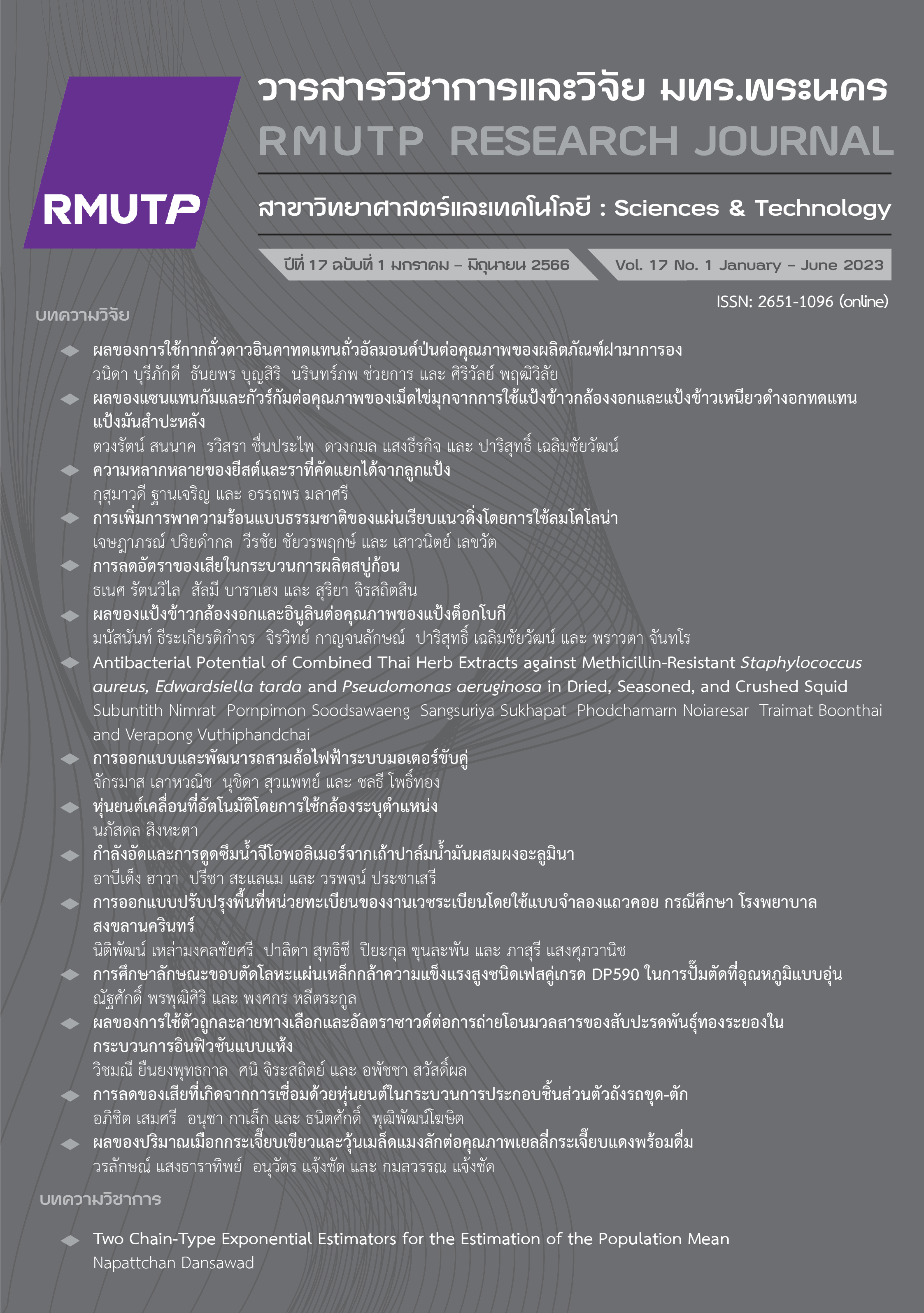กำลังอัดและการดูดซึมน้ำจีโอพอลิเมอร์จากเถ้าปาล์มน้ำมันผสมผงอะลูมินา
Main Article Content
บทคัดย่อ
ในการศึกษาครั้งนี้เป็นการศึกษากำลังอัดจีโอพอลิเมอร์มอร์ตาร์จากเถ้าปาล์มน้ำมัน ซึ่งจีโอพอลิเมอร์มอร์ตาร์ถูกเตรียมจากเถ้าปาล์มน้ำมันและผงอะลูมินา ใช้สารอัลคาไลน์จากโซเดียมซิลิเกตและโซเดียมไฮดรอกไซด์ จีโอพอลิเมอร์มอร์ตาร์ผสมระหว่างเถ้าปาล์มน้ำมันและผงอะลูมินาในอัตราส่วน 100:0, 95:5, 90:10 และ 85:15 โดยน้ำหนัก และมีการเปลี่ยนแปลงอัตราส่วนวัสดุประสาน (เถ้าปาล์มน้ำมัน+ผงอะลูมินา) ต่อสารอัลคาไลน์ และอัตราส่วนวัสดุประสานต่อมวลรวมละเอียด ก้อนตัวอย่างใช้การบ่มร้อนที่อุณหภูมิ 80 องศาเซลเซียส เป็นเวลา 24 ชั่วโมง และบ่มต่อที่อุณหภูมิห้อง 1, 7 และ 28 วัน เพื่อทดสอบกำลังอัด ซึ่งผลการทดสอบแสดงให้เห็นว่ากำลังอัดของจีโอพอลิเมอร์
มอร์ตาร์จากเถ้าปาล์มน้ำมันมีค่าเพิ่มขึ้นเมื่อใช้ผงอะลูมินาเข้ามาทดแทน ค่ากำลังอัดที่เด่นชัดในการศึกษาครั้งนี้เป็นจีโอพอลิเมอร์ที่ผสมผงอะลูมินาร้อยละ 10 ใช้มวลรวม 3.00 และสารอัลคาไลน์ 1.44 สามารถให้กำลังอัดที่ดีที่สุดและยังสามารถให้ความหนาแน่นน้อยที่สุด
Article Details

อนุญาตภายใต้เงื่อนไข Creative Commons Attribution-NonCommercial-NoDerivatives 4.0 International License.
ลิขสิทธ์ ของมหาวิทยาลัยเทคโนโลยีราชมงคลพระนครเอกสารอ้างอิง
A. Hawa, “Properties of pumice lightweight concrete containing rubber wood fly ash and rice husk ash” M.S. thesis, Dept. of Civil Eng. Prince of Songkla Univ., Songkhla, Thailand, 2008.
P. Chindaprasirt, S. Homwuttiwong and C. Jaturapitakul, “Strength and water permeability of concrete containing palm oil fuel ash and rice husk–bark ash,” Construction and Building Materials, vol. 21, no. 7, pp. 1492-1499, Jul. 2007.
S. Ruhzon and P. Chindaprasirt, “Use of waste ash from agricultural by-products in concrete work,” RMUTP Research Journal, vol. 2, no. 1, pp. 49-56, Mar. 2008.
W. Tangchirapat and C. Jaturapitakkul, “Strength, drying shrinkage, and water permeability of concrete incorporating ground palm oil fuel ash,” Cement and Concrete Composites, vol. 32, no. 10, pp. 767-774, Nov. 2010.
W. Tangchirapat, C. Jaturapitakkul and P. Chindaprasirt, “Use of palm oil fuel ash as a supplementary cementitious material for producing high-strength concrete,” Construction and Building Materials, vol. 23, no. 7, pp. 2641-2646, Jul. 2009.
J. Temuujin, W. Rickard and A. van Riessen, “Characterization of various fly ashes for preparation of geopolymers with advanced applications,” Advanced Powder Technology, vol. 24, no. 2, pp. 495-498, Mar. 2013.
G. Görhan and G. Kürklü, “The influence of the NaOH solution on the properties of the fly ash-based geopolymer mortar cured at different temperatures,” Composites: Part B, vol. 58, pp. 371–377, Mar. 2014.
M. T. Junaid, O. Kayali, A. Khennane and J. Black, “A mix design procedure for low calcium alkali activated fly ash-based concretes,” Construction and Building Materials, vol. 79, pp. 301-310, Mar. 2015.
A. Hawa, D. Tonnayopas, W. Prachasaree and P. Taneerananon, “Development and performance evaluation of very high early strength geopolymer for rapid road repair,” Advances in Materials Science and Engineering, vol. 2013, Aug. 2013.
M. Y. Liu, C. P. Chua, U. J. Alengaram and M. Z. Jumaat, “Utilization of palm oil fuel ash as binder in lightweight oil palm shell geopolymer concrete,” Advances in Materials Science and Engineering, vol. 2014, Jan. 2014.
M. Olivia, L. M. Tambunan and E. Saputra, “Properties of palm oil fuel ash (POFA) geopolymer mortar cured at ambient temperature,” in International Conference on Engineering Technology (ETIC 2016), Ho Chi Minh City, Vietnam, 2016, pp. 36-42.
Standard Specification for Coal Fly Ash and Raw or Calcined Natural Pozzolan for Use in Concrete, ASTM C618-12a, 2012.
A. Mahama, F. Saleah and F. Soko, “A Study of Geopolymer Mortar from Oil Palm Ash with Alumina Powder,” B. Eng project, Dept. Civil Eng., Princess of Naradhiwas Univ., Narathiwat, Thailand, 2017.
Standard Specification for Concrete Aggregates, ASTM C33/C33M-18, 2018.
Standard Test Method for Relative Density (Specific Gravity) and Absorption of Fine Aggregate, ASTM C128-15, 2015.
Standard Test Method for Compressive Strength of Hydraulic Cement Mortars (Using 2-in. or [50-mm] Cube Specimens), ASTM C109/C109M-16a, 2016.
S. Rukzon, T. Tansathit, P. Seesai and P. Chindaprasirt, “Physical properties of geopolymer mortar palm oil fuel ash,” Engineering Journal of research and Development, vol. 32, no. 1, pp. 89-103, Jan.-Mar. 2021.
N. Ranjbara, M. Mehralib, U. Johnson Alengarama, H. S. C. Metselaar and M. Z. Jumaat, “Compressive strength and microstructural analysis of fly ash/palm oil fuel ash based geopolymer mortar under elevated temperatures,” Construction and Building Materials, vol. 65, pp. 114-121, Aug. 2014.
N. Ranjbara, M. Mehralib, U. Johnson Alengarama, H. S. C. Metselaar and M. Z. Jumaat, “Compressive strength and microstructural analysis of fly ash/palm oil fuel ash based geopolymer mortar,” Materials and Designs, vol. 59, pp. 532-539, Aug. 2014.
A. Hawa, D. Tonnayopas and W. Prachasaree, “Performance Evaluation and Microstructure Characterization of Metakaolin-Based Geopolymer Containing Oil Palm Ash,” The Scientific World Journal, vol. 2013, Oct. 2013.
A. Hawa, D. Tonnayopas and W. Prachasaree, “Performance evaluation of metakaolin based geopolymer containing parawood ash and oil palm ash blends,” Materials Science, vol. 20, no. 3, pp. 339-344, Sep. 2014.
A. Hawa, W. Prachasaree and D. Tonnayopas, “Effect of water-to-powder ratios on the compressive strength and microstructure of metakaolin based geopolymers,” Indian Journal Engineering Materials Science, vol. 24, no. 6, pp. 499-506, Dec. 2017.
C. Y. Heah, H. Kamarudin, A. M. Mustafa Al Bakri, M. Bnhussain, M. Luqman, I. K. Nizar, C. M. Ruzaidi and Y. M. Liew, “Study on solids-to-liquid and alkaline activator ratios on kaolin-based geopolymers,” Construction and Building Materials, vol. 35, pp. 912-922, Oct. 2012.


